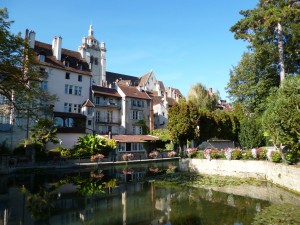 Returning from a wonderful Swiss trip we decided to meander awhile in the less frequeted Jura area of France which we were to pass through. Our first stop was on the shore of Lake St. Point at Malbuisson. Some maps show this village as being in the Jura, some as being in the Doubs, either way it does fall under the overall umbrella of the Jura mountain range. Here we stayed on Camping Les Fuvettes, our pitch being only about twenty metres from the water’s edge. A gentle river-side walk to the village soon shew us they were smarting the area up with new footpaths and floral displays. There seems to be a lot of this updating of many of Frances’s villages near to, or part of, a tourist area. Although only a small village it does have a couple of quaint looking hotels and restaurants, a Tourist Office as well as a large shop which sells only local produce, ranging from wines to cheeses from the villages own factory. This factory produces the Comté cheese, made in the traditional fashion in big copper cauldrons. The campsite has a small animal enclosure which was supposed to keep the goats and llamas in, only the goats had escaped during our stay and were roaming freely among the vans. Fanning out from behind the site there were numerous walking trails in the woods or along the lake shore.
Returning from a wonderful Swiss trip we decided to meander awhile in the less frequeted Jura area of France which we were to pass through. Our first stop was on the shore of Lake St. Point at Malbuisson. Some maps show this village as being in the Jura, some as being in the Doubs, either way it does fall under the overall umbrella of the Jura mountain range. Here we stayed on Camping Les Fuvettes, our pitch being only about twenty metres from the water’s edge. A gentle river-side walk to the village soon shew us they were smarting the area up with new footpaths and floral displays. There seems to be a lot of this updating of many of Frances’s villages near to, or part of, a tourist area. Although only a small village it does have a couple of quaint looking hotels and restaurants, a Tourist Office as well as a large shop which sells only local produce, ranging from wines to cheeses from the villages own factory. This factory produces the Comté cheese, made in the traditional fashion in big copper cauldrons. The campsite has a small animal enclosure which was supposed to keep the goats and llamas in, only the goats had escaped during our stay and were roaming freely among the vans. Fanning out from behind the site there were numerous walking trails in the woods or along the lake shore.
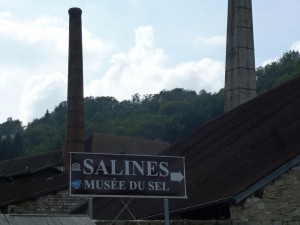
The second stopover in the Jura was at the old salt mining town of Salins-les-Bains. Interestingly the name originates from its saline waters, used for bathing and drinking, now the town’s Spa Baths are as popular as ever. After topping up our provisions at the edge of town Super-U supermarket we drove the length of the town to the little municipal campsite.
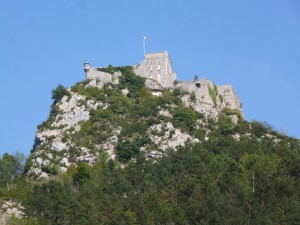
The shops are all along the one really long main street, with two forts perched high on hills, either side of the valley that the town nestles in. A well guarded place in times past. The towns other claim to fame is its salt mining history, of which it has a museum and conducts guided tours of the old underground tunnels. These tunnels still house an eighteenth century hydraulic pumping system, alas no longer working as production ceased in the early nineteen sixties. Unfortunately the tours are only in French, so we skipped this. Fairly recently (2009) the historic salt works became a UNESCO World Heritage Site. To make up for missing the mines we had a lovely walk through the small park and along the river behind the main street. I was lucky enough to see a pair of Kingfishers as they skimmed just above the river, don’t see that every day.
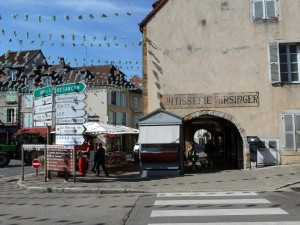 Our Rough Guide to France suggested the ancient town of Arbois to be well worth a visit, so that’s where we headed next. The short drive there was on quiet narrow back-roads, all went well till we reached Arbois. Turned out to be market day and where we thought we could easily park, outside Chateau Pecauld to visit its Musee De La Vigne, there were parked cars everywhere, including on the pavements. We decided to retreat to the sanction of the municipal Campsite Les Vignes on the edge of town. The grass pitches all sloped a fair bit and our wedges weren’t enough to level us. After eventually pitching our van, (why does it take us a lot longer to choose a pitch on a near empty site, spoilt for choice I suppose), a ten minute stroll along the narrow lanes took us to into town.
Our Rough Guide to France suggested the ancient town of Arbois to be well worth a visit, so that’s where we headed next. The short drive there was on quiet narrow back-roads, all went well till we reached Arbois. Turned out to be market day and where we thought we could easily park, outside Chateau Pecauld to visit its Musee De La Vigne, there were parked cars everywhere, including on the pavements. We decided to retreat to the sanction of the municipal Campsite Les Vignes on the edge of town. The grass pitches all sloped a fair bit and our wedges weren’t enough to level us. After eventually pitching our van, (why does it take us a lot longer to choose a pitch on a near empty site, spoilt for choice I suppose), a ten minute stroll along the narrow lanes took us to into town.
Arbois town centre was rather quaint with raised covered walkways and a central square with small streets fanning out from it. One such street taking you down to the young river Cuiasance. Another street houses the family home of Louis Pasteur, now a museum to the great man.
The Jura area is famed not only for fine wines generally but Arbois is also known for the Vin Jaune (yellow wine) and Vin de Paille (straw wine), which almost every other shop seemed to sell, at a price.
The day we walked into town was sunny and hot so we took the advice from the Rough Guide and sampled the wares of the Chocolatier M. Hirsinger, a delicious double boule ice-cream, at his pavement emporium. Sitting outside this so French watering hole, watching the world go by, the reality of everyday life seems quite distant. After which we sought out the Chateau Pecauld again, this time on foot. At only €3.5 each for entry it proved good value for an hour or so. The models and pictures seemed as much about glass blowing as wine producing, interesting though, even with the video being in French. Back in the town there are numerous Cave’s in which to sample and purchase the wines of Arbois and the surrounding vineyards. Also some of the local walks take you through the lower slopes of vineyards.
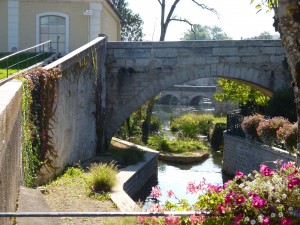 Although our trusty Rough Guide gave virtually no information about the next town we wished to visit, we had been told verbally that Dole was worth a stopover, and so it turned out to be. After entering the town of Dole we drove along the banks of the River Doubs to the Camping Pasquie campsite (which was beside the picturesque canal, complete with live-aboards on their colourful boats).
Although our trusty Rough Guide gave virtually no information about the next town we wished to visit, we had been told verbally that Dole was worth a stopover, and so it turned out to be. After entering the town of Dole we drove along the banks of the River Doubs to the Camping Pasquie campsite (which was beside the picturesque canal, complete with live-aboards on their colourful boats).
 With the prospect of another hot and dry day forecast we decided to explore Dole, or The Little Venice of the Jura as our literature from the Tourist Office described it. As it turned out this had a grain of truth to it. A town plan leaflet incorporates a tourist walk “Circuit du Chat Perche”, which follows ground level bronze Cat symbols. We found it a great help as it showed and described thirty five places including buildings, streets and areas of interest. We started at the huge water
With the prospect of another hot and dry day forecast we decided to explore Dole, or The Little Venice of the Jura as our literature from the Tourist Office described it. As it turned out this had a grain of truth to it. A town plan leaflet incorporates a tourist walk “Circuit du Chat Perche”, which follows ground level bronze Cat symbols. We found it a great help as it showed and described thirty five places including buildings, streets and areas of interest. We started at the huge water 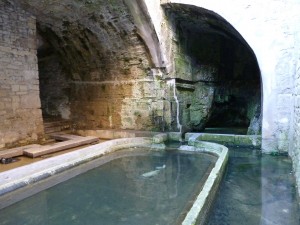 fountain opposite the Tourist Office and spent a whole afternoon exploring the town and gardens, even the old underground Baths. The entrance to this bath house and underground spring is partly hidden under , what is termed as, the last arch of Raynaud-III, so you need to follow the trail closely. Although no longer in use as a leisure bath it is still on view as part of a walkway from the upper street to the lower river area. Exiting the old Baths you emerge at
fountain opposite the Tourist Office and spent a whole afternoon exploring the town and gardens, even the old underground Baths. The entrance to this bath house and underground spring is partly hidden under , what is termed as, the last arch of Raynaud-III, so you need to follow the trail closely. Although no longer in use as a leisure bath it is still on view as part of a walkway from the upper street to the lower river area. Exiting the old Baths you emerge at 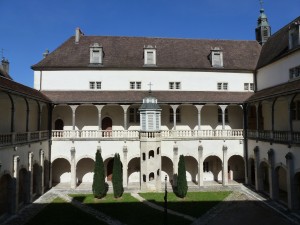 a convenient waterside café, time for “ deux biere blonde, s’il vous plait “. With old churches, museum, a Gothic Basilica and numerous small waterways, the Cat takes you on an interesting tour of discovery, mostly on pedestrian streets and narrow walkways.
a convenient waterside café, time for “ deux biere blonde, s’il vous plait “. With old churches, museum, a Gothic Basilica and numerous small waterways, the Cat takes you on an interesting tour of discovery, mostly on pedestrian streets and narrow walkways.
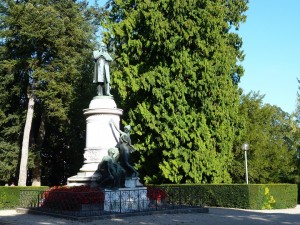 Before returning over the flower bedecked bridge to our home on wheels a stroll round the lovely park/gardens beckoned. At the park entrance was a musical carousel entertaining a group of children, a nice piece of old time innocence. The trees still held some late summer colour and with a babbling stream, complete with waterfalls and a little grotto, it’s a place to dwell and relax. Worth locating near the park’s entrance is a formidable statue of Louis Pasteur, who was born here but grew up in nearby Arbois.
Before returning over the flower bedecked bridge to our home on wheels a stroll round the lovely park/gardens beckoned. At the park entrance was a musical carousel entertaining a group of children, a nice piece of old time innocence. The trees still held some late summer colour and with a babbling stream, complete with waterfalls and a little grotto, it’s a place to dwell and relax. Worth locating near the park’s entrance is a formidable statue of Louis Pasteur, who was born here but grew up in nearby Arbois.
All too soon the time came to head for home.